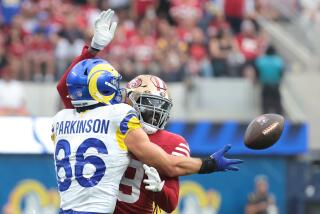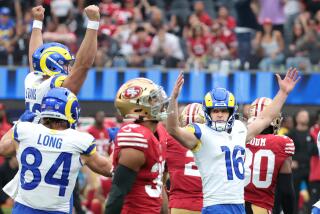THE NFL / BOB OATES : Montana Looks as Good as New, but 49ers Don’t
As another exhibition season began over the weekend, the most important happening was the effortless return of Joe Montana, the four-time Super Bowl winner from San Francisco.
Blindsided and knocked out of the NFC title game seven days before last winter’s Super Bowl, Montana ended his 12th season with assorted injuries--including a broken throwing hand--and the 49ers yielded the championship to the New York Giants.
He played only the first quarter against the Raiders in an exhibition at the Coliseum Saturday, but it was a typically crisp Montana performance. Completing five of six passes in the familiar short-pass offense that has made the 49ers famous, he also survived a sack.
“I’m good as new,” Montana said, commenting on off-season surgery.
And he looked it. Although he will never see 34 again, he already seems ready for his 13th season.
Balance trouble: The 49ers’ problems, which are serious, are elsewhere. They have lost the ability to run the ball, and they have lost their depth in the offensive line.
When tackle Bubba Paris reported too fat to play, it was the 350-pound straw that broke their back.
Coach George Seifert had to turn a Pro Bowl guard, Harris Barton, into a tackle and shift Steve Wallace to Paris’ spot.
“We’re kind of scrambling in the (offensive line),” Seifert said.
Moreover, his 1990 first draft choice, starting halfback Dexter Carter, hasn’t proved to be quick enough to compensate for his 170 pounds.
As a consequence, when it was first team against first team in the first quarter Saturday, San Francisco’s running game couldn’t budge the Raider defense.
Last season the 49ers’ 14-2 record was the NFL’s best, but they got into trouble in the playoffs. Forsaking their ground game, they asked Montana to throw more often than former coach Bill Walsh contemplated when the offensive system was designed in the 1980s.
“You need balance to win (Super Bowls),” Walsh said.
As good as Montana is, the 49ers are out of balance, and their future depends on what they do about it.
Small-school mining: In the NFL’s first of several overseas American Bowls this summer, the Buffalo Bills got some help Sunday from their second draft choice, defensive end Phil Hansen of North Dakota State, who sacked Philadelphia’s Jim McMahon to end the Eagles’ late drive.
That forced the Eagles to go for a field goal and a 13-10 lead that wasn’t enough on a neutral field, Wembley Stadium near London, where the Bills, defending AFC champions, came back to win, 17-13.
If the score is least important in an exhibition, the circumstances that lead to it are often revealing. In this case, there was a suggestion that Buffalo General Manager Bill Polian has found one more defensive lineman to complement all-pro Bruce Smith and the others.
Hansen, who stands 6 feet 5 and weighs 271, is one of half a dozen small-college players the Bills acquired in this year’s draft, when they avoided USC, Notre Dame and Michigan to concentrate on Northern Michigan, Pittsburg (Kan.) and even North Dakota State.
“Everyone says there’s a lot of talent in the (small) schools,” said Polian. “We hope we’ve got some of it.”
Tokyo Raiders: NFL players remain divided in their attitude toward the overseas games. The trips are long and arduous, but there are many things to do in, say, Tokyo, where the Raiders will practice against the Miami Dolphins this week before taking them on in an exhibition game Saturday.
The clubs, unlike the players, see more advantages than negatives in the American Bowl series. Raider executive Al LoCasale lists three pluses.
“It’s an opportunity to practice three days against another team instead of beating on your own people,” LoCasale said. “It gives us an opportunity to practice awhile in warm weather. As great as our Oxnard facility is, it’s been a bit cold this summer.
“Lastly, American Bowl teams play five (exhibition) games instead of four. That’s an extra four quarters of football, in game conditions, to (evaluate and strengthen) the team.”
Raider owner Al Davis will take off today with a Tokyo-bound cast of 300, including players’ wives and girlfriends and two dozen former players. He said there’s only one rule: “Any veteran can bring a wife, as long as it’s his own wife.”
Remembering 1951: This is the 40th anniversary of the Rams’ only NFL championship for Los Angeles after their 1945 predecessors won it for Cleveland. And in recognition of the achievement, survivors of the 1951 champions will be honored twice this month.
Fetes are planned for the Bonaventure Hotel Aug. 16 at noon and for Anaheim Stadium Aug. 17, the night of the the Rams’ exhibition against the Seattle Seahawks.
Harry Thompson, a 1950-54 Ram guard from UCLA, attributes the team’s one local championship to “the intangibles,” not talent.
The 1951 Rams also had some talent, he concedes, naming Hall of Fame receivers Tom Fears and Elroy (Crazylegs) Hirsch, who, according to Thompson, plan to attend along with 26 teammates.
Four other Ram Hall of Famers--quarterbacks Bob Waterfield and Norm Van Brocklin, owner Dan Reeves and Coach Joe Stydahar--are deceased.
Among the standouts were defenders Don Paul, Tank Younger and Woodley Lewis, guard Dick Daugherty and ballcarriers Dan Towler, Dick Hoerner, Glenn Davis and two-way star Younger.
They beat the Cleveland Browns, 24-17--in what is known now as the Super Bowl--on a long pass from Van Brocklin to Fears.
Steroid policy: Outlining the 1991 substance-abuse policy, NFL Vice President Joe Browne said: “Every player in the league will be tested for steroids in training camp.
“(Thereafter), an average of seven players on each team will be tested weekly on a random basis. (They) are selected by computer on a coded or ‘blind’ basis.”
The league is gaining on steroids, Browne said, administering 6,000 tests last year and catching only three users.
More to Read
Go beyond the scoreboard
Get the latest on L.A.'s teams in the daily Sports Report newsletter.
You may occasionally receive promotional content from the Los Angeles Times.










